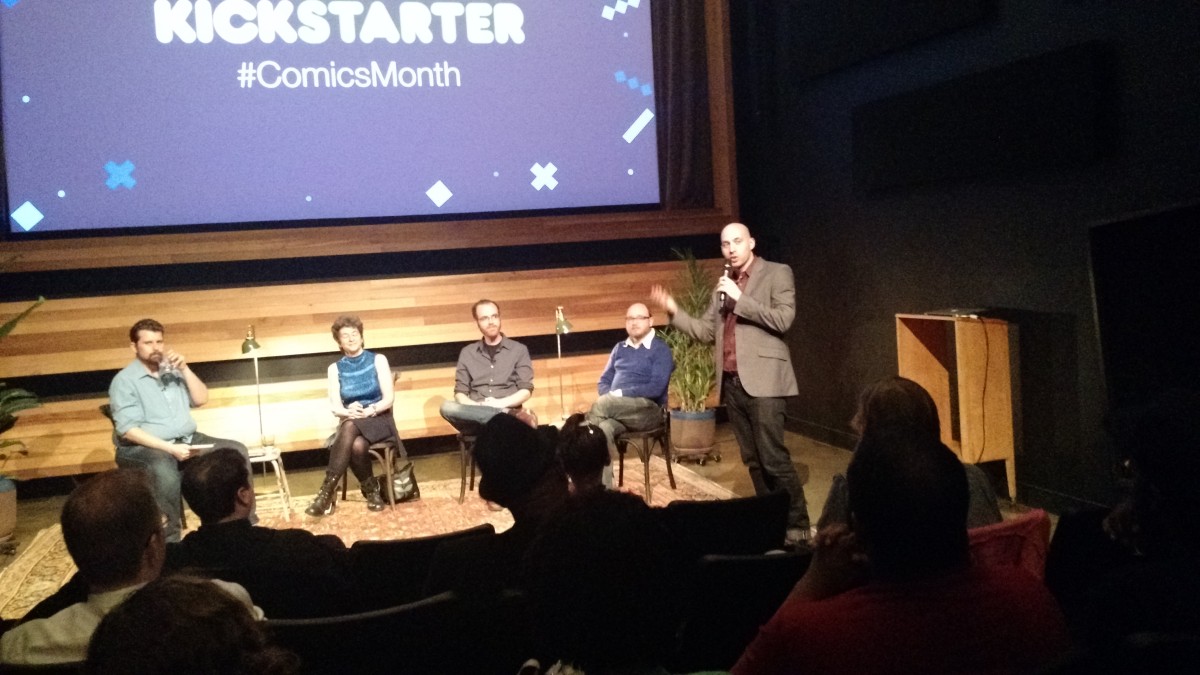If you draw comics, you should be submitting them for sale in the biggest comic book shop in the world, the ComiXology online store. That was the message from John D. Roberts, one of the site’s cofounders, at an event at Kickstarter Wednesday.
There is a fierce debate in the world of comics right now about whether comics are better or worse in digital formats, but, much like the debate in print books, it’s really all over but the shouting. The shouting will probably go on for a good long while, but the health of Manhattan’s ComiXology, acquired a year ago by Amazon, shows strong signs that going digital has been healthy for the art form.
It's a great time to be in comics, because the only thing limiting you is yourself and the time you have.
If you’ve followed the comics industry since the last dot-com crunch, you know that even as superheroes have taken over the silver screen, the medium that gave birth to them has been contracting dramatically.
Hundreds of comic book stores have closed and the monthly sales numbers for big name books are, at their best, what would have been cancellation numbers in the 1970s and ’80s. In fact, Roberts said during the Q&A that every comic book fan he’s ever known has come up with a plan to save comics.
What he didn’t say (and he wasn’t trying to say), is that it could be that he and his two cofounders have actually done it.
Roberts spoke at Kickstarter this week at a #ComicsMonth event for the company, at a panel organized by indie comics artist and Kickstarter staffer Jamie Tanner. It was called “Talking Shop: Comics Past, Present and Future.”
Roberts said that the minimum viable product for the site was simply making a quick and easy way for comics fans to search online and see what new comics were coming out that week (for comics fans, every Wednesday is Christmas — that’s when new comics hit the shelves at comics shops). Before ComiXology, the main comics distributor, Diamond, put out a giant text file of new comics coming out, but not in a way that anyone could use. ComiXology took that file, ran it through a database and turned it into a website that readers could search and see what to expect at the shops on Wednesday.
“If you look at the original business plan,” Roberts said, “we always wanted to get into digital comics.” In 2009, when the first iPhone came out, they saw that there was a screen and platform that could actually make a comic readable. Once Apple made in-app purchasing available, he said the team knew that that was their moment.
They built a platform that made comics readable on mobile and then reached out to some big creators to do work for the early ComiXology app. Brian Clevinger and Scott Wegener’s Atomic Robo was the very first comic published on their system, Roberts said.
“It’s a great time to be in comics, because the only thing limiting you is yourself and the time you have,” Roberts said.
He encouraged comics artists in the room to submit their work to be published on ComiXology. The site has standards for what it publishes, but Roberts was there to encourage artists to submit their work.
A few highlights from the broader conversation, which also included Karen Green (documentary producer and graphic novels librarian at Columbia University), Comic Book Legal Defense Fund Executive Director Charles Brownstein and Locust Moon co-owner Joshua O’Neill.
- Roberts said that they’ve seen strong growth in women reading comics on the platform. Comic book shops have a reputation for being uncomfortable for girls (this non-female comics fan also found them intimidating, even in college).
- Another ComiXology customer uses the app to conceal from his spouse how much he’s spending on comics.
- “Comics are a medium that people mistake for a genre,” O’Neill said.
- Who’s indexing webcomics? “That’s an ephemeral form that’s going to disappear if something isn’t done and I don’t know who’s going to do it,” Green said, adding that there are protocols for those sorts of archives, based on Columbia’s work saving human rights websites that tend to disappear. We made a list of five Brooklyn webcomics in 2013.
- “It seems there are new models that reward the depth of your relationship with your fans rather than their numbers,” O’Neill said, pointing to sites like Patreon and the night’s host, Kickstarter. He added that one day it may not be that people only have 15 minutes of fame. He speculated, “Maybe in the future, everyone is going to be famous, but only to fifteen people.”
The state of comics right now is very strange. Even as sales have slumped horribly over the form’s heyday, more people are making more kinds of comics than ever before. There’s more creators, more publishers and more diversity in the fan base than there has been for a long time. That said, creators have a hard time making any real money off their work.
Join the conversation!
Find news, events, jobs and people who share your interests on Technical.ly's open community Slack
